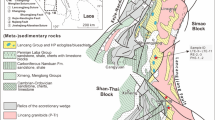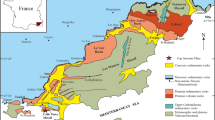Abstract
Mercury mines in Guizhou province are the main base of mercury production and the most important resource base in China. The San-Dan mercury belt in Guizhou province contains a series of important mercury deposits. However, the source of metallogenic materials and the properties of metallogenic fluid of these mercury deposits have long been a controversial issue. In this study, we used cathode luminescence techniques to distinguish different stages of dolomite and calcite, laser ablation inductively coupled plasma mass spectrometry to analyze the trace elements, and stable isotope mass spectrometry techniques to analyze C–O isotopes compositions of dolomite and calcite in the Sixiangchang mercury deposit in San-Dan mercury belt. We also measured the sulfur isotope composition of cinnabar. Our study showed that dolomite can be divided into two stages, the lumpy dolomite associated with cinnabar in Dol 1 stage and dolomite vein in Dol 2 stage, which is associated with Cal 2 stage calcite vein. With the progress of mineralization, Al, As, Mo, Sb, and Sr elements were gradually enriched in the ore-forming fluid. The rare earth element (REE) partition curve of Dol 1 stage dolomite showed a trend of light REE enrichment. Cal 2 stage calcite and Dol 2 stage dolomite exhibited a flat-type REE partition curve, and Dol 2 stage dolomite showed a strong negative anomaly for Eu. δ13C of carbonate mineral variation ranges from − 6.89 to − 2.16 ‰, while δ18O variation ranges from 13.80 to 23.09 ‰, and the δ34S variation range of cinnabar is 16.51–24.28 ‰. Carbonate mineral trace elements and C–O isotopes compositions suggested that early ore-forming fluid was reduced, and late ore-forming fluid was oxidized. The ore-forming fluid of the Sixiangchang mercury deposit is a mixture of deep crustal fluid and meteoric water in deep thermal circulation, and involved in the oxidation of organic matter. The cinnabar δ34S results showed that sulfur mainly came from seawater sulfate with the participation of microbial reduction. Sulfur is sedimentary in origin and was derived mainly from the host-rock strata.

Modified from Hu and Zhou (2012)

Modified from Huang and Du (1993)








Modified from Chang et al. (2008)
Similar content being viewed by others
References
Bao YM, Wan RJ, Bao ZX (1999) Discussion of the mercury mineralization related to the mercury metallogeic belt of Hunan-Guizhou province. Beijing Geol 2:5–12 (in Chinese with English abstract)
Chacko T, Mayeda TK, Clayton RN, Goldsmith JR (1991) Oxygen and carbon isotope fractionations between CO2 and calcite. Geochim Cosmochim Acta 55(10):2867–2882
Chang ZS, Large RR, Maslennikov V (2008) Sulfur isotopes in sediment-hosted orogenic gold deposits: evidence for an early timing and a seawater sulfur source. Geology 36(12):971–974
Chaussidon M, Albare F, Sheppard SM (1989) Sulphur isotope variations in the mantle from ion microprobe analyses of microsulphide inclusions. Earth Planet Sci Lett 92(2):144–156
Chen L, Liu YS, Hu ZC, Gao S, Zong KQ, Chen HH (2011) Accurate determinations of fifty–four major and trace elements in carbonate by LA-ICP-MS using normalization strategy of bulk components as 100%. Chem Geol 284:283–295
Demény A, Sitnikov M, Karchevsky P (2004) Stable C and O isotope compositions of carbonatite complexes of the Kola Alkaline Province: phoscorite-carbonatite relationships and source compositions. In: Wall F, Zaitsev AN (eds) Phoscorites and carbonatites from mantle to mine: the key example of the Kola Alkaline Province. Mineral Soc, London, pp 407–431
Du YS, Huang H, Yang JH, Huang HW, Tao P, Huang ZQ, Hu LS, Xie CX (2013) The basin translation from Late Paleozoic to Triassic of the Youjiang basin and its tectonic signification. Geol Rev 59:1–11 (in Chinese with English abstract)
Friedman L, O’Neil JR (1977) Compilation of stable isotope fractionation factors of geochemical interest. In: Fleischer M (ed) Data of geochemistry, sixth edn. Geological Survey Professional Paper, Reaton, VA, vol 440-KK, pp KK1–KK12Han ZC
He LX (1990) The forming condition and existing regularity of Au mineralization in Hg ore belt. Geol Guizhou 7(3):187–195 (in Chinese with English abstract)
Hoefs J (1997) Stable isotope geochemistry. Springer, Berlin
Hu RZ, Zhou MF (2012) Multiple Mesozoic mineralization events in South China-an introduction to the thematic issue. Mineral Deposita 47:579–588
Hu RZ, Su WC, Bi XW, Tu GZ, Hofstra AH (2002) Geology and geochemistry of Carlin-type gold deposits in China. Miner Deposita 37:378–392
Hu RZ, Fu SL, Huang Y, Zhou MF, Fu SH, Zhao CH, Wang YJ, Bi XW, Xiao JF (2017) The giant South China Mesozoic low-temperature metallogenic domain-reviews and a new geodynamic model. J Asian Earth Sci 137:9–34
Huang GS, Du YY (1993) The features and genesis of micrograined and disseminated gold deposit in Shan Dan Hg-ore zone. Geol Guizhou 34(1):1–9 (in Chinese with English abstract)
Jia RF, Chen QN, Zhou PK, Xia Y, Wu XY (1993) Relation between Au-enrichment periods and organic matter in Danzhai gold deposit Guizhou. Contrib Geol Miner Resour Res 8(4):69–81 (in Chinese with English abstract)
Jochum KP, Scholz D, Stoll B (2012) Accurate trace element analysis of speleothems and biogenic calcium carbonates by LA-ICP-MS. Chem Geol 2012:318–319
Jochum KP, Weis U, Stoll B, Kuzmin D, Jacob DE, Stracke A, Birbaum K, Frick DA, Günther D, Enzweiler J (2015) Determination of reference values for NIST SRM 610-617 glasses following ISO guidelines. Geostand Geoanal Res 35:397–429
Lei YJ, Dai YP, Duan QF, Wang GQ, Zhao WQ (2012) Rotational shear tectonics and metallogeny of the of the mercury ore belt in Hunan and Guizhou Provinces, China. Geotectonic et Metallogenia 36(4):525–529
Li ZZ, Zhou DK (1988) Diagenesis of mercury ore zone in Tongren-Fenghuang-Sandu-Danzhai region. Oil Gas Geol 9(4):428–435
Li HY, Gao ZM, Yang ZS, Luo TY, Rao WB (2002) Geochemical features of Danzhai Carlin-type gold deposit, Guizhou Province. Chin J Geol 37(1):1–7 (in Chinese with English abstract)
Li BH, Li WW, Gu XX, Xiao DC, Huang ZB, Cheng WB, Chen CH, Dong SY (2013) A study of methane inclusion of the Danzhai mercury ore field in Guizhou Province and its geological significance. Earth Sci Front 20(1):55–63 (in Chinese with English abstract)
Liu YS, Hu ZC, Gao S, Günther D, Xu J, Gao CG, Chen HH (2008) In situ analysis of major and trace elements of anhydrous minerals by LA-ICP-MS without applying an internal standard. Chem Geol 257:34–43
Liu YS, Hu ZC, Zong KQ (2010) Reappraisement and refinement of zircon U-Pb isotope and trace element analyses by LA-ICP-MS. Chin Sci Bull 55(15):1535–1546 (in Chinese with English abstract)
Möller P (1997) Rare earth element and yttrium fractionation caused by fluid migration. Geoscience 42:43
Möller P (2002) Rare earth elements and yttrium in geothermal fluids. Water Sci Technol Libr 40:97–125
Möller P, Lüders V, Schröder J, Luck J (1991) Element partitioning in calcite as a function of solution flow rate: a study on vein calcites from the Harz Mountains. Miner Deposita 26:175–179
Möller P, Dulski P, Morteani G (2003) Partitioning of rare earth elements, yttrium, and some major elements among source rocks, liquid and vapor of Larderello-Travale geothermal field, Tuscany (Central Italy). Geochim Cosmochim Acta 67:171–183
O’Neil JR, Clayton RN, Mayeda TK (1969) Oxygen isotope fractionation in divalent metal carbonates. Chem Phys 51(12):5547–5558
Ohmoto H (1972) Systematics of sulfur and carbon isotopes in hydrothermal ore deposit. Econ Geol 67:551–578
Robinson BW, Kusakabe M (1975) Quantitative preparation of sulfur dioxide, for 34S/32S analyses, from sulfides by combustion with cuprous oxide. Anal Chem 47(7):1179–1181
Rollinson HR (1993) Using geochemical data: evaluation, presentation, interpretation. Longman Scientific and Technical, Copublished in the U.S. with J. Wiley and Sonswenle
Rytuba JJ (2003) Mercury from mineral deposits and potential environmental impact. Environ Geol 43(3):326–338
Saupe F (1990) Geology of the Almaden mercury deposit, Province of ciudad real, Spain. Econ Geol 85(3):482–510
Shi JX (1991) On the relationship between organic matter and mercury mineralization in eastern guizhou in special reference to organic inclusion data. Acta Mineral Sinica 11(4):341–345 (in Chinese with English abstract)
Su WC, Xia B, Zhang H, Zhang XC, Hu RZ (2008) Visible gold in arsenian pyrite at the Shuiyindong Carlin-type gold deposit, Guizhou, China: implications for the environment and processes of ore formation. Ore Geol Rev 33:667–679
Su WC, Heinrich CA, Pettke T, Zhang XC, Hu HR, Xia B (2009) Sediment-hosted gold deposits in Guizhou, China: products of wall-rock sulfidation by deep crustal fluids. Econ Geol 104:73–93
Su WC, Zhang HT, Hu RZ, Ge X, Xia B, Chen YY, Zhu C (2012) Mineralogy and geochemistry of gold-bearing arsenian pyrite from the Shuiyindong Carlin-type gold deposit, Guizhou, China: implications for gold depositional processes. Miner Deposita 47(6):653–662
Su WC, Dong WD, Zhang XC, Shen NP, Hu RZ, Albert H, Cheng LZ, Xia Y, Yang KY (2018) Carlin-type gold deposits in the dian-qian-gui “golden triangle” of southwest China. Rev Econ Geol 20:157–185
Veizer J, Ala D, Azmy K, Bruckschen P, Buhl D, Bruhn F, Carden GAF, Diener A, Ebneth S, Godderis Y (1999) 87Sr/86Sr, δ13C, and δ18OV-SMOW evolution of Phanerozoic seawater. Chem Geol 161:1586
Wang JS, Gao ZH (2017) Geochemical characteristics and implications of REE, carbon and oxygen isotopes of calcite from La’e Mercury Deposit. J Kunming Univ Sci Technol 42(3):28–37 (in Chinese with English abstract)
Wang JS, Wen HJ (2015) Sm-Nd dating of hydrothermal calcites from JiaoLi-Lae Mercury deposit, Guizhou Province. J Jilin Univ Earth Sci Ed 45(5):1384–1393 (in Chinese with English abstract)
Wang ZH, Chen JB, Feng XB, Hintelmann Holger, Yuan SL, Cai HM, Huang Q, Wang SX, Wang FY (2015) Mass-dependent and mass-independent fractionation of mercury isotopes in precipitation from Guiyang, SW China. CR Geosci 347:358–367
Wei AY, Xue CD, Xiang K, Li J, Liao C, Qureshi JA (2015) The ore-forming process of the Maoping Pb–Zn deposit, northeastern Yunnan, China: constraints from cathodoluminescence (CL) petrography of hydrothermal dolomite. Ore Geol Rev 70:562–577
Xie ZJ, Xia Y, Yan BW, Wang ZP, Tan QP, Wu SR, Fan RC (2014) Geochemical characteristics and metallognic materials source of Carlin-type gold deposits in the Sandu-Danzhai metallogenic zone, Guizhou. Bull Mineral Petrol Geochem 33(3):326–333 (in Chinese with English abstract)
Yan JP, Yang KW, Wang HY, Zeng RL, Ding LX, Li Q, Li LY, Xiang MM, Huang CL (1989) Mercury deposits in guizhou. Geological Publishing House, Beijing, pp 1–366 in Chinese with English abstract
Zheng YF, Hoefs J (1993) Carbon and oxygen isotopic covariations in hydrothermal calcites. Miner Deposita 28:79–89
Zhou ZB, Wen HJ, Qin CJ, Liu L (2017) Geochemical and isotopic evidence for a magmatic-hydrothermal origin of the polymetallic vein-type Zn–Pb deposits in the northwest margin of Jiangnan Orogen, South China. Ore Geol Rev 86:673–691
Acknowledgements
This study was funded by the National 973 Program of China (2014CB440906) and the key project of the National Natural Science Foundation of China (41230316). We thank Dai Zhihui and Tang Yanwen for LA-ICP-MS analysis, Gu Jing for C, O and S isotopes analysis.
Author information
Authors and Affiliations
Corresponding author
Rights and permissions
About this article
Cite this article
Zhuo, Y., Huang, Y., Li, J. et al. Fluid properties and sources of Sixiangchang carbonate-associated mercury deposit, southwest China. Acta Geochim 38, 670–682 (2019). https://doi.org/10.1007/s11631-019-00362-w
Received:
Revised:
Accepted:
Published:
Issue Date:
DOI: https://doi.org/10.1007/s11631-019-00362-w




